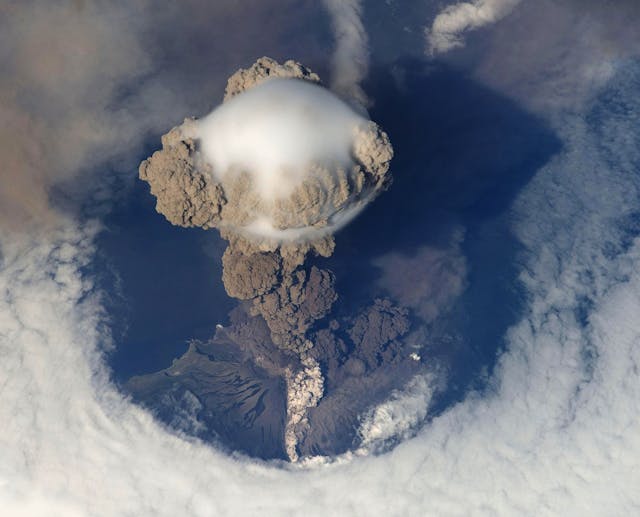
What is a supervolcano? A supervolcano is a volcano that has had an eruption, or has the potential of an eruption, that is an 8 on the volcanic explosive index.
We have scales to measure the size of hurricanes, the strength of earthquakes, and many other things. Well, there is a scale to measure the strength of a volcano and it is called the Volcanic Explosive Index (VEI). It was invented in 1982, and it looks at the size and the height of the plume, the amount of material ejected, and the amount of magma. It is a logarithmic scale, which means that each number is ten times more powerful than the number before it. The scale goes from 0 to 8. A 0 is a volcano that puts out less than 10,000 m3 of material and with a plume that is less than 100 m tall. These volcanoes can still be dangerous, but not so much. These type of eruptions are called Hawaiian eruptions because they most often happen on the Hawaiian islands. They don’t have a huge plume, but they can put out a lot of very hot lava that burns everything in its path. This lava creates more land as it hits the sea, making the islands bigger.
Then, at the other end, is 8. An 8 puts out more than 1,000 km3 of material and has a plume that reaches higher than 20 km. These are supervolcanoes and, luckily for us, they are rare. A supervolcano is predicted to erupt once every 50,000 years. The last supervolcano eruption was the Oruanui eruption, which happened on the North Island of New Zealand 26,500 years ago. Category 8 volcanoes are called Ultra-Plinian because they are named for Pliny the Younger who was the Roman that documented the eruption of Mount Vesuvius that destroyed Pompeii in 79 AD. Vesuvius was only a category 5 volcano.
A supervolcano is so large that when it erupts it can change the global climate. Supervolcanoes put so much ash and other particles into the atmosphere that they can bring down global temperatures. This is often called a nuclear winter because it would happen after a nuclear war. The particles in the atmosphere are very light and get carried around the world on the trade winds. Once they are suspended in the atmosphere, they reflect away sunlight, causing the opposite of a greenhouse effect. This was seen when Mount Pinatubo erupted in 1991. It was the biggest eruption since Krakatoa in 1883 and it had a plume that was 40 km high. it put out billions of tons of magma and so many particles into the atmosphere that global temperatures dropped by 0.5 degrees. And Mt. Pinatubo was only a category six on the VEI. That makes it 100 times smaller than any supervolcano would be. Incidentally, some people are thinking that putting particles in the atmosphere like this might be a way of combatting climate change. I’m not sure if it would work.
The largest ever supervolcano eruption was the Wah Wah Springs Caldera. The caldera was discovered in 2013, and it is estimated that the eruption released almost 6,000 km3 of matter and magma into the atmosphere and the pyroclastic flows would have been over 500 m thick, would have traveled for hundreds of kilometers, and would probably have traveled at 800 km/h. This volcano erupted 30 million years ago. A supervolcano erupts when the magma in its magma chamber has built up too much pressure and then everything is expelled. Once the eruption is over, there is nothing left in the magma chamber and it collapses back in on itself becoming a hollow in the ground. This is called a caldera and it can be huge.
There are potentially 20 supervolcanoes on Earth right now. There may be more, there may be less. It is difficult to tell because it is difficult to know how much magma is attached to a volcano and what kind of force it will erupt with. Yellowstone Park is often cited as a supervolcano that could go off at any time, but the Yellowstone volcano seems to erupt roughly every 700,000 years, which means we have another 100,000 years to go. And there is no way of knowing when any volcano will erupt. Supervolcanoes are on top of a magma chamber that is constantly increasing in size. The sheer quantity of magma underneath them is what gives them their enormous power. When Yellowstone erupted the last time, it left a caldera that is 50 km long and 70 km wide. That gives you an idea of how much magma was expelled during the eruption. And that is what I learned today.
Sources
https://www.usgs.gov/faqs/what-a-supervolcano-what-a-supereruption
https://www.nhm.ac.uk/discover/what-is-a-supervolcano.html
https://en.wikipedia.org/wiki/Supervolcano
https://en.wikipedia.org/wiki/Wah_Wah_Springs_Caldera
https://en.wikipedia.org/wiki/Oruanui_eruption
https://en.wikipedia.org/wiki/Volcanic_explosivity_index
https://www.nps.gov/subjects/volcanoes/volcanic-explosivity-index.htm
https://science.howstuffworks.com/nature/natural-disasters/volcano.htm
https://www.nhm.ac.uk/discover/what-is-a-supervolcano.html
https://volcanoes.usgs.gov/volcanic_ash/pinatubo_1991.html
https://www.sunnysports.com/blog/3-biggest-volcano-eruptions-50-years
https://education.nationalgeographic.org/resource/when-sleeping-giant-awakes
Photo by Pixabay: https://www.pexels.com/photo/top-view-of-volcano-erupting-during-daytime-73828/
